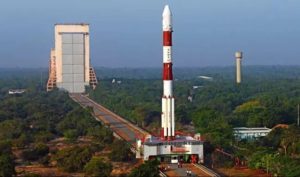ISRO Launches IRNSS-1l Navigation Satellite Successfully From Sathish Dhawan Space Centre In Sriharikota
Sriharikota ( Andhra Pradesh): The Indian Space Agency ISRO (Indian Space Research Organisation) launched its IRNSS-1l navigation satellite, the eighth such satellite to be a part of a constellation, from Sriharikota in Andhra Pradesh.

PSLV-C41/IRNSS-1l Mission was launched at 4.04 am from the first Launchpad at the Sathish Dhawan Space Centre. According to the officials at ISRO the launch was a normal lift-off.
IRNSS-1l is to function in place of IRNSS-1A, the first of the previously launched seven navigation satellites which was rendered ineffective after the three rubidium atomic clocks it in failed to function. The seven satellites are the integral part of the NavIC navigation satellite constellation.

The launch is considered to be ISRO’s second attempt at sending a replacement satellite.
The earlier mission which was loaded on a PSLV carrying IRNSS-1H in August last year failed after the heat shield covering the satellite failed to separate.
The IRNSS-1l mission takes place just two weeks after the space agency launched the ill-fated GSAT-6A on board GSLV Mk-II. Though they were successful in placing GSAT-6A in orbir through the rocket launch, but later the ISRO lost communication with the satellite within two days.
The ISRO Chairman K. Sivan said after the launch, “I am extremely happy to announce that the PSLV has precisely injected the navigation satellite in the targeted orbit.”
The costly Rs. 1,420 crore Indian satellite navigation system – Indian Regional Navigation Satellite System now called NavIC – comprises of nine satellites, seven placed in orbit and two as substitutes.
The 1,425 kg IRNSS-1I will be the second satellite launched as replacement for IRNSS-1A and the ninth of the IRNSS satellite series.
After a time of 19 minutes, 20 seconds following the lift-off, the rocket will sling IRNSS-1I at an estimated altitude of around 507 km.
The launch is the 41st successful launch out of 43 total launches.
Each satellite has a life span of a total 10 years.
The previous IRNSS missions which joined ISRO’s NavIC navigation satellite constellation are IRNSS-1A (launched on July 01, 2013), IRNSS-1B (launched on April 04, 2014), IRNSS-1C (launched on October 16, 2014), IRNSS-1D (launched on March 28, 2015), IRNSS-1E (January 20, 2016), IRNSS-1F (launched on March 10, 2016), IRNSS-1G (launched on April 28, 2016), and IRNSS-1H (launched on August 31, 2017). All such launches except IRNSS-1H have been successful. Their main purpose is to build India’s self-made navigation system – similar to the US’ GPS or Global Positioning System. The orbit of some of the IRNSS satellites is placed in geo-stationary mode or GEO, while some are geo-synchronous or GSO.
On August 31, 2017, ISRO launched the IRNSS-1H to be able to join its NavIC navigation satellite constellation. IRNSS-1H was actually planned to be launched by PSLV-C39 into a sub Geosynchronous Transfer Orbit (sub-GTO) with a 284 km perigee and 20,650 km apogee with an inclination of 19.2 degrees with respect to the equatorial plane. The lift-off of the PSLV-C39 rocket carrying the IRNSS-1H satellite was normal as per the reports, but, the mission was unsuccessful as the IRNSS-1H satellite could not be placed in accordance into the orbit properly.
You May Also Read: Indian Space Agency Ready To Launch PSLV-C41/IRNSS-1I Mission – See Details